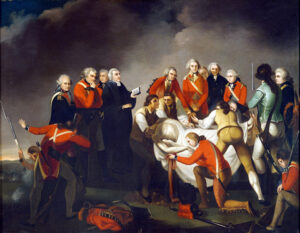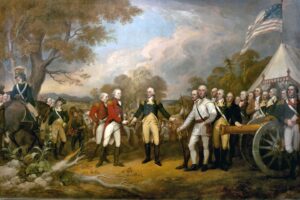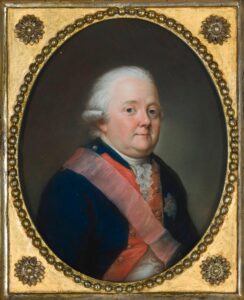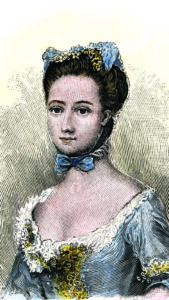Threads of History
Charlotte Riedesel, Mrs. General
“The Most Beloved Woman in the Army”
By John Krueger, Chair of the LCBP Heritage Area Program Advisory Committee

Friederike Charlotte Louise von Massow by Johann Heinrich Wilhelm Tischbein, 1762. Friedrich’s marriage to the sixteen-year-old Charlotte was arranged by their families. It was also a love match that produced nine children in twenty-two years. This wedding portrait dates from several months before the December 1762 marriage. It is the basis for all the various woodcuts.
Frederika Charlotte Louise von Massow was about thirteen when she first met Friedrich Riedesel, a dashing twenty-one-year-old cavalry officer and aide to the Duke of Brunswick.[1] Known to her family as Charlotte, she was born on July 11, 1746, at Brandenburg in northeastern Germany. The beautiful daughter of a lieutenant-general who was the commissary in chief for King Frederick II of Prussia, Charlotte as a child had followed her father on military campaigns in central Europe. Friedrich Riedesel was born on June 3, 1738, at Lauterbach in central Germany. He enlisted in the army at the age of seventeen with his first assignment near London. Friedrich did not know French or English but learned both languages while in England.[2]
Friedrich’s marriage to the sixteen-year-old Charlotte on December 21, 1762, at Wolfenbüttel, Brunswick’s capital city, was arranged by their families. That the marriage was also a love match is clear from the letters the couple exchanged when apart. After the marriage, Friedrich left on a tour of duty while Charlotte went to live in Berlin. There, in 1767, she gave birth to a son, the first of nine children she would bear. Three, including the first two, died in infancy. Friedrich was stationed at Wolfenbüttel, where he bought a home and the couple lived quietly for several years during which time two daughters, Gustava and Frederica, were born.[3]
Charlotte was pregnant again in January 1776 when the Duke of Brunswick contracted with Great Britain to send 3,964 foot soldiers and 336 light cavalrymen to America to fight against the rebellious colonists. Friedrich was promoted to major general and named commander of the Brunswick army. He left Wolfenbüttel on February 22. That night he poured out his heart to Charlotte, “Never have I suffered more than upon my departure this morning. My heart was broken; and could I have gone back who knows what I might have done!” He added, “my own Mrs. General, take good care of your health, in order that you may follow me as quickly as possible after your happy delivery.”[4]
Friedrich sailed for America with the understanding that Charlotte would join him as soon as the new baby could travel. He arrived at Quebec on June 1, 1776, and supported the final expulsion of the American invaders from Canada.[5] [link to October 2021 Thread] Charlotte was determined to follow her husband, much to the dismay of her mother, who had ordered her to remain at home with the children. “The thought that you begged me – nay, commanded me to remain here, made me shudder,” she wrote her mother. “Yet to remain, when the best, the tenderest of husbands allowed me to follow him, would have been impossible. Duty, love and conscience forbade it. It is the duty of a wife to leave all and follow her husband. My love for him is known to you, as well as his for me and the children.” The baby, another daughter, Caroline, was born in March.[6]
On May 14, 1776, Charlotte left Wolfenbüttel accompanied by her three daughters – Gustava four years and nine months old; Frederica two years old; and Caroline ten weeks old – two German maids, a servant, and a nurse. The twenty-nine-year-old baroness kept a journal in which she recorded her adventures and observations. The distinguished historians Henry Steele Commager and Richard B. Morris, editors of The Spirit of “Seventy-Six: The Story of the American Revolution as Told by Participants, acknowledge Charlotte as the “best of all the women chroniclers of the Revolution.”[7]
She awaited her ship to Canada in Bristol, where she claimed to learn the English language and customs in six weeks. Friedrich insisted that Charlotte travel with a companion, a “lady of standing,” and as a result she was unable to set sail for Canada until April 16, 1777.[8] General Riedesel’s family arrived at Quebec early on the morning of June 10. When news reached the city, Charlotte was “saluted with cannon by all the ships in the harbor; and…we saw a boat approaching us, containing twelve sailors dressed in white, and wearing silver helmets and green sashes. These seamen had been sent to fetch me from the ship, and they brought me a letter from my husband.” “I depart this instant, my love, for St. John,” Friedrich had written to his “Dearest Wife” from Three Rivers on June 5, “in order to pass from that point through Lake Champlain to New England.”
Undeterred, Charlotte pressed on from Quebec, finally uniting with Friedrich at Chambly on June 15 for two days. They had been apart for almost sixteen months. “My joy was beyond all description,” she confided in her diary, “but the sick and feeble appearance of my husband terrified me, and a little disheartened me.” Charlotte and the girls settled at Three Rivers and remained there for two months.[9]
Charlotte, the children, and her entourage joined Burgoyne’s main force on August 14, two days before “the unlucky affair at Bennington.” [link to August 2022 Thread] The Germans were camped at Fort Edward, with the Hudson River on their right. Charlotte and Friedrich managed to share a few moments of stolen bliss in the American wilderness. “We led, during these three weeks, a very pleasant life. The surrounding country was magnificent; and we were encircled by the encampments of the English and German troops. We lived in a building called the Red House. I had only one room for my husband, myself, and my children, in which my husband also slept, and had besides all his writing materials. My women servants slept in a kind of hall. When it was beautiful weather we took our meals under the trees, but if not, in a barn, upon boards, which were laid upon casks and served as a table.”[10]
Friedrich Riedesel and John Burgoyne communicated with each other in French, as did most British and German officers. Because Friedrich had been one of the Duke of Brunswick’s favorite staff officers, he had more practical experience than Burgoyne commanding an army. Approximately 300 women accompanied Burgoyne’s troops, including seventy-seven wives of Brunswick soldiers. Charlotte was included in a small group of officers’ wives who followed some distance behind the first line of advance.[11]
She was with the army on September 19 and was close enough to the front to observe the Battle of Freeman’s Farm. “I was an eyewitness of the whole affair; and as I knew that my husband was in the midst of it, I was full of care and anguish, and shivered at every shot, for I could hear everything. I saw a great number of wounded, and…they even brought three of them into the house where I was.” She described how she cared for a young English officer: “I tendered him my services and sent him provisions and refreshments. He had bled considerably, and they wished to take off his leg, but he could not bring his mind to it, and now mortification had set in. I sent him pillows and coverings, and my women servants [provided] a mattress. I redoubled my care of him and visited him every day. Finally, they attempted the amputation of the limb, but it was too late, and he died a few days afterward.”[12]
On the crisp and clear autumn morning of October 7 Charlotte and Friedrich were having breakfast when she heard a commotion outside. The baron told her that his men were going out on a reconnaissance. She walked with him before he left with his staff. On her way back to the house – where she planned to give a dinner for Generals Burgoyne, Phillips, and Fraser that evening – Charlotte “met many savages in their war-dress, armed with guns. To my question where they were going, they cried out to me, ‘War! War!’” The agitated young mother hurried to her daughters. “Our misfortunes may be said to date from this moment,” she wrote. The Battle of Bemis Heights was about to begin.
“I had scarcely got back to my quarters, when I heard skirmishing, and firing, which by degrees, became constantly heavier, until, finally, the noises became frightful. It was a terrible cannonade, and I was more dead than alive. About three o’clock in the afternoon, in place of the guests who were to have dined with me, they brought in to me, upon a litter, poor General [Simon] Fraser (one of my expected guests), mortally wounded.”
The table was cleared to make a bed for the general, who died the next morning. Fraser had requested that his body be buried at six o’clock in the evening in the Great Redoubt. Burgoyne fulfilled his fallen comrade’s last wish at the designated time and place. Charlotte observed the funeral under American cannon fire. “Many cannon balls also flew not far from me, but I had my eyes fixed upon the hill, where I distinctly saw my husband in the midst of the enemy’s fire, and therefore I could not think of my own danger.”[13]

The Burial of General Simon Fraser by John Graham 1791. National Army Museum, London, England. Born in Scotland in 1729, Fraser joined the army as a lieutenant in 1755. Promoted to captain before Quebec in 1759, he was in General James Wolfe’s boat crossing the St. Lawrence. Fraser’s reply in French through the fog enabled the British force to sneak ashore before ascending to the Plains of Abraham. Fraser was the officer in whom Burgoyne had the greatest confidence.
A general retreat began immediately after Fraser’s burial. “We traveled continually the whole night,” Charlotte wrote. “Little Frederica was afraid, and would often begin to cry. I was, therefore, obliged to hold a pocket handkerchief over her mouth, lest our whereabouts should be discovered.”[14] Both Friedrich and Charlotte condemned Burgoyne’s nonchalance during the retreat. Charlotte was disgusted that Burgoyne “spent half the nights in singing and drinking, and amusing himself with the wife of a commissary, who was his mistress, and who, as well as he, loved champagne.”[15]
After marching north through torrential rains with their equipment mired in mud the baroness took refuge near Saratoga (present day Schuylerville) in what is now known as the Marshall House, a large wooden building with a stone cellar where she sheltered with her small children, assorted women, and wounded officers and soldiers. “We were finally obliged to take refuge in a cellar, in which I laid myself down in a corner not far from the door. My children laid down on the earth with their heads upon my lap, and in this manner we passed the entire night.”

The Surrender of General Burgoyne by John Trumbull 1821. Yale University Art Gallery, New Haven, Connecticut. Friedrich Riedesel assured his Brunswickers on the morning of October 17 that it was no fault of theirs that had brought them to this point. He collected all of the regimental flags and gave them to Charlotte, who engaged “a right honorable tailor” to help her make a mattress” in which the flags were sewn to be taken secretly back to Brunswick.
She spent several days and nights managing the crowded cellar. “I at once set many hands to work,” Charlotte recalled, “which was in the highest degree necessary; for the women and children being afraid to venture forth, had soiled the whole cellar.” One soldier described her as an “angel of comfort” who “restored order in that chaos,” while another observed that his comrades “obeyed her more readily than their superior officers.”[16]
Following Burgoyne’s surrender by the convention of Saratoga on October 17, Charlotte and the children accompanied Friedrich into captivity. The Riedesel family traveled with the defeated army to Boston, where they were to sail back to Europe. The terms of surrender were rejected by Congress, however, and the prisoners spent the next four years as the Convention Army. For a year they lived comfortably in Cambridge in “an agreeable situation,” before they were ordered to Virginia in November 1778.[17]
Friedrich was paroled in the summer of 1779, and the family left Virginia for New York City. Another daughter, named America, was born on March 7, 1780. General Riedesel spent nearly a year on parole before being exchanged. The family was permitted to leave New York in the summer of 1781. They travelled to Canada, where on November 5 Charlotte gave birth to a fifth daughter, named Canada, who survived only five months.
With the end of the war in 1783, the family was finally able to return to Germany. Georg, the long-awaited male heir, was born in April 1785. The last of their nine children, a daughter named Charlotte, was born in October 1788 when Charlotte was forty-two years old. Friedrich served with the Brunswick troops in the Netherlands from 1788 to 1793. After a year of retirement at Lauterbach, he was recalled and placed in command of the city of Brunswick. He died there on January 6, 1800, at the age of sixty-one.

Friedrich Riedesel by Johann Heinrich Schroder circa 1795. National Museum, Warsaw, Poland. Although Friedrich Riedesel had more experience with large armies in the field than John Burgoyne, he was not fully taken into his commanding officer’s council’s and was made to feel the outsider.
Having been encouraged by her husband, Charlotte published her journal and letters in a limited edition for circulation in the family shortly after Friedrich’s death. A devoted wife and mother who had been endorsed by her husband’s forces as “the most beloved woman in the army,” she died at Berlin on March 29, 1808, at the age of sixty-one and was buried next to Friedrich in the Riedesel family vault at Lauterbach.[18]

Friedrich Riedesel by Johann Heinrich Schroder circa 1795. National Museum, Warsaw, Poland. Although Friedrich Riedesel had more experience with large armies in the field than John Burgoyne, he was not fully taken into his commanding officer’s council’s and was made to feel the outsider.
[1] “Ried-esel, pronounced Re-day-zel, with accent on second syllable. The cockneys in the British army pronounced it Red-hazel.” William Leete Stone Jr., editor and translator, Letters and Journals Relating to the War of the American Revolution, and the Capture of the German Troops at Saratoga. By Mrs. General Riedesel (Albany, NY: Joel Munsell, 1867), 5n. Charlotte’s father was Hans Jürgen Detloff von Massow. Lorraine McMullen, “Massow, Friederike Charlotte Louise von,” Dictionary of Canadian Biography, Volume V, 1801-1820 (Toronto: University of Toronto Press, 1983), 582-584.
[2] https://www.riedesel.org/wp-content/uploads/2014/08/general1.pdf. https://geneee.org/friedrich+adolf/riedesel?lang=en. Richard M. Ketchum, Saratoga: Turning Point of America’s Revolutionary War (New York, NY: Henry Holt and Company, 1997), 125-132. If you read just one book on the 1777 campaign, this is the book you want to read. Highly recommended.
[3] Stone, Letters and Journals, 13-16.
[4] Stone, Letters and Journals, 17-18.
[5] Friedrich sailed aboard the Pallas, the same ship that had carried General Thomas Gage back to England from America. “In case you the journey,” he wrote Charlotte on June 28, “you will find in Quebec Lieutenant-Colonel Baum with the dragoons, who has already taken pains to procure good quarters for you.” On October 26, 1776, Friedrich wrote to Charlotte from Crown Point, “On Board the Washington, a prize taken from the rebels,” telling her that “Our campaign is at an end; and I shall go back to Three Rivers, where I am to be stationed this winter, and await you with the greatest impatience.” Stone, Letters and Journals, 23, 30, 32, 35.
[6] Caroline never married. She lived until 1861. Stone, Letters and Journals, 36-37.
[7] Henry Steele Commager and Richard B. Morris, editors, The Spirit of ‘Seventy-Six: The Story of the American Revolution as Told by Participants (New York, NY: Harper & Row, 1967), 867.
[8] Stone, Letters and Journals, 28-29, 38-62, 68-77.
[9] Stone, Letters and Journals, 81-93.
[10] Ketchum, Saratoga, 291; Stone, Letters and Journals, 77n, 92-93.
[11] Ketchum, Saratoga, 130, 342.
[12] Stone, Letters and Journals, 114-115.
[13] The quarters that Charlotte then occupied, and in which General Fraser died, has since been known as the Smith House. Stone, Letters and Journals, 116-122; Ketchum, Saratoga, 391-392, 399-400.
[14] Stone, Letters and Journals, 122.
[15] Stone, Letters and Journals, 125.
[16] Stone, Letters and Journals, 127-128, 128n.
[17] Stone, Letters and Journals, 134-160.
[18] In 1801 another edition was published for public circulation. This work was translated into Dutch in 1802 and into English in New York in 1827. The translation was not very accurate. William Leete Stone Jr. (1835-1908) prepared a more accurate edition in 1867. The quotations in this essay are from Stone’s edition. Stone delivered the historical address at the laying of the cornerstone of the Saratoga Monument on October 17, 1877, the centennial of Burgoyne’s surrender.
